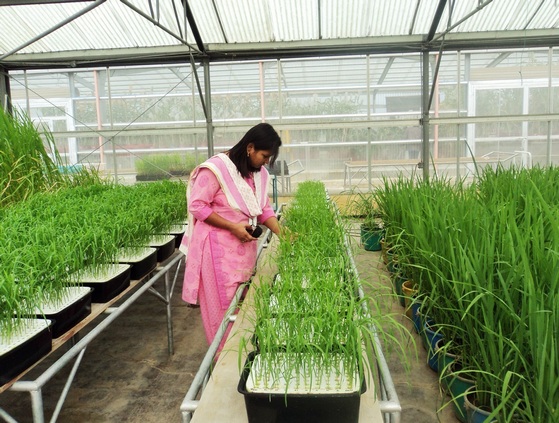Two in one, in more ways than one
Armin Bhuiya (pictured) is a dynamic and lively young geneticist and plant breeder, who has made huge strides in tracking crucial genes in Bangladeshi rice landraces (or traditional farmer varieties). Armin took a ‘sandwich’ approach twinning two traits – salt and submergence tolerance – in order to boost farmers’ yields. Her quest for salt-impervious ‘amphibian’ rice has seen her cross frontiers to The Philippines, and back to her native Bangladesh with solutions that will make a difference, borrowing a leaf along the way from the mythical submarine world of Atlantis for life under water. Using cutting-edge crop science, Armin is literally recreating out-of-this-world stuff working two elements of the ancient world – earth and water – plus that commodity that was then so prized enjoying a premium comparable to gems: salt. Read on!
A rice heritage, and the ‘sandwich’ saga and submarine search both begin…
“My father worked at the Bangladesh Rice Research Institute (BRRI), which basically means I grew up in rice research. You could say that I was born and bred in agriculture and this inspired me to study agriculture myself,” says Armin. As a result of these early experiences, Armin started a master’s degree in 2006 on genetics and plant breeding, specialising in hybrid rice. Ever since, rice has been her religion, following in the footsteps of her father to join the Bangladesh Rice Research Institute (BRRI).
Her other defining hallmark is her two-in-one approach. Sample this: once she completed her two-in-one master’s, Armin went on to study for a PhD in the same twin areas at Bangladesh Agricultural University. Pondering long and hard on what research would be of most practical use, she asked herself “What is the need? What research will be useful for my country and for the world?” (Editorial aside: out of this world work, apparently…)
Not content pondering over the question by herself, her natural two-track approach kicked in. Mulling with her colleagues from BRRI, the answer, it first seemed, was to find ways to produce salt-tolerant high-yielding rice. In Bangladesh and many other parts of South and Southeast Asia, climate change is driving up the sea level, spreading salinity further and deeper across low-lying coastal rice-fields, beyond the bounds where salt-drenched terrain has long been a perennial problem. Modern rice varieties are highly sensitive to salt. So, despite the low yields and quality, farmers continue to favour hardy traditional rice landraces that can take the heat and hit from the salt. Proceeding from this earthy farmer reality and inverting the research–development continuum, Armin needed no further thinking as the farmers showed the way to go. Her role and the difference she could make was to track the ‘treasure’ genes locked in these landraces that were transferred to high-yielding but salt-sensitive rice varieties, to fortify them against salt.
But that was not all. There’s power in numbers and consulting others, harnessing the best in diversity. In comes the two-track approach again, with Armin now turning to fellow scientists again, with the reality from farmers. Upon further consultations with colleagues, yet another fundamental facet emerged that could not be ignored. Apparently, salt-impervious rice alone would not be not enough, and here’s why. Salt and tides aside, during the rainy season inland, flash floods regularly submerge the fields, literally drowning the crop. More than 20 million hectares in South and Southeast Asia are affected – including two million hectares in coastal Bangladesh alone. The southern belt of Bangladesh is particularly affected, as modern varieties are sensitive to not only submergence but also salinity. So Armin had her work cut out for her, and she now knew that for the fruit of her labour to boost rice production in coastal regions as well (two tracks again! Inland and coastal low-lying rice-lands), what she needed to do was to work on producing high-yielding, salt-impervious, ‘amphibian’ rice that could withstand not only salinity but also submarine life. In other words, pretty much rice for a latter-day real-life rendition of the mythical Atlantis.
Armin has successfully incorporated dual tolerance to salinity and submergence in the popular Bangladeshi mega-variety BR11. This will provide the ideal salt-tolerant ‘amphibian’ rice suitable for farmers in the flood-prone salty-water-drenched swaths of southern Bangladesh.”
Through the door of opportunity
The opportunity that opened the door for Armin to fulfil her dream was a DuPont Pioneer postgraduate fellowship implemented by GCP. The competitive programme provides grants for postgraduate study in plant breeding and genetics to boost the yields of staple food crops. This fellowship took Armin to Filipino shores and the molecular breeding labs at the International Rice Research Institute (IRRI). Here she got what she terms a golden opportunity to work under the tutelage of Abdelbagi Ismail, a leading plant physiologist focusing on overcoming abiotic stresses. From him, Armin learnt how carry out the precise meticulous research required for identifying quantitative trait loci (QTLs).
Armin conducted her research with two different mapping populations, both derived from Bangladeshi landraces (Kutipatnai and Ashfal). She found a total of nine quantitative trait loci (QTLs) from one mapping population and 82 QTLs from another for tolerance to salinity stress at seedling stage (QTL is a gene locus where allelic variation is associated with variation in a quantitative trait). Incorporating these additional genes into a high-yielding variety will help to develop promising salt-tolerant varieties in future. She has also successfully incorporated QTLs for dual tolerance to salinity (Saltol) and submergence (Sub1) in the popular Bangladeshi mega-variety, BR11. Stacking (or ‘pyramiding’ in technical terms) Saltol and Sub1 QTLs in BR11 will provide the ideal salt-tolerant ‘amphibian’ rice suitable for farmers in the flood-prone salty-water-drenched swaths of southern Bangladesh.
I know what to do and what is needed… I am going to share what I learned with my colleagues at BRRI and agricultural universities, as well as teach these techniques to students”
Dream achiever and sharer: aspiring leader inspiring change
The Pioneer–GCP fellowship has given Armin the opportunity to progress professionally. But, more than that, it means that through this remarkable young scientist, others from BRRI will benefit – as will her country and region. “While I was at IRRI,” Armin says, “I trained myself in modern molecular plant-breeding methods, as I knew that this practical experience in high-tech research methods would definitely help Bangladesh. I know what to do and what is needed. I am going to share what I learned with my colleagues at BRRI and agricultural universities, as well as teach these techniques to students. It makes me very happy and my parents very proud that the fellowship has helped me to make my dream come true.”
Away from professional life, there have been benefits at home too, with these benefits delivered with Armin’s aplomb and signature style in science – doing two in one, in more ways than one. This time around, the approach has led to dual doctorates for a dual-career couple in different disciplines: “When I went to The Philippines” Armin reveals, “my husband decided to come with me, and took the opportunity to study for a PhD in development communications. So we were both doing research at the same time!”
While Armin’s research promises to make a real difference in coastal rice-growing areas, Armin herself has the potential to lead modern plant breeding at her institute, carry GCP work forward in the long term, post-GCP, and to inspire others as she herself was inspired – to make dreams come true and stimulate change. An inspired rice scientist is herself an inspiration. You will agree with us that Armin personifies Inspiring change, our favoured sub-theme for International Women’s Day this year.
Go, Armin, Go! We’re mighty proud of what you’ve achieved, which we have no doubt serves as inspiration for others!
Links
- Poster and poster abstract (p 32) on Armin’s work
- PHOTO: Armin at GCP’s General Research Meeting 2013. Photo-story coming soon!
- Profiles: Zeba Seraj (University of Dhaka, Bangladesh) and Abdelbagi Ismail (IRRI)









